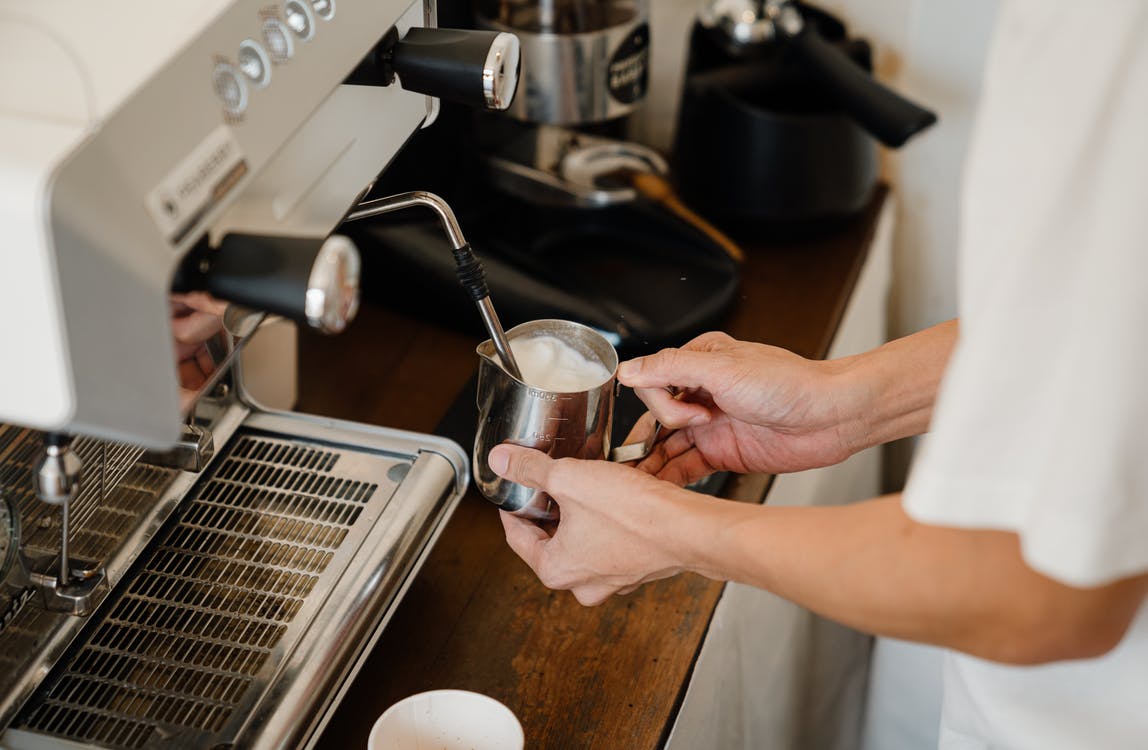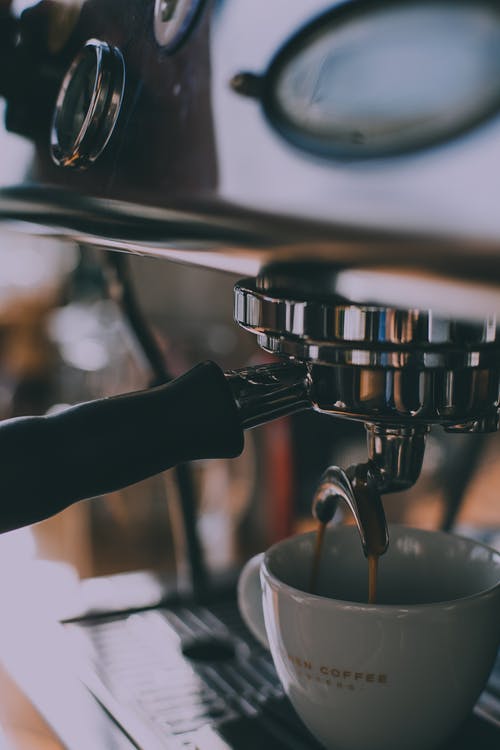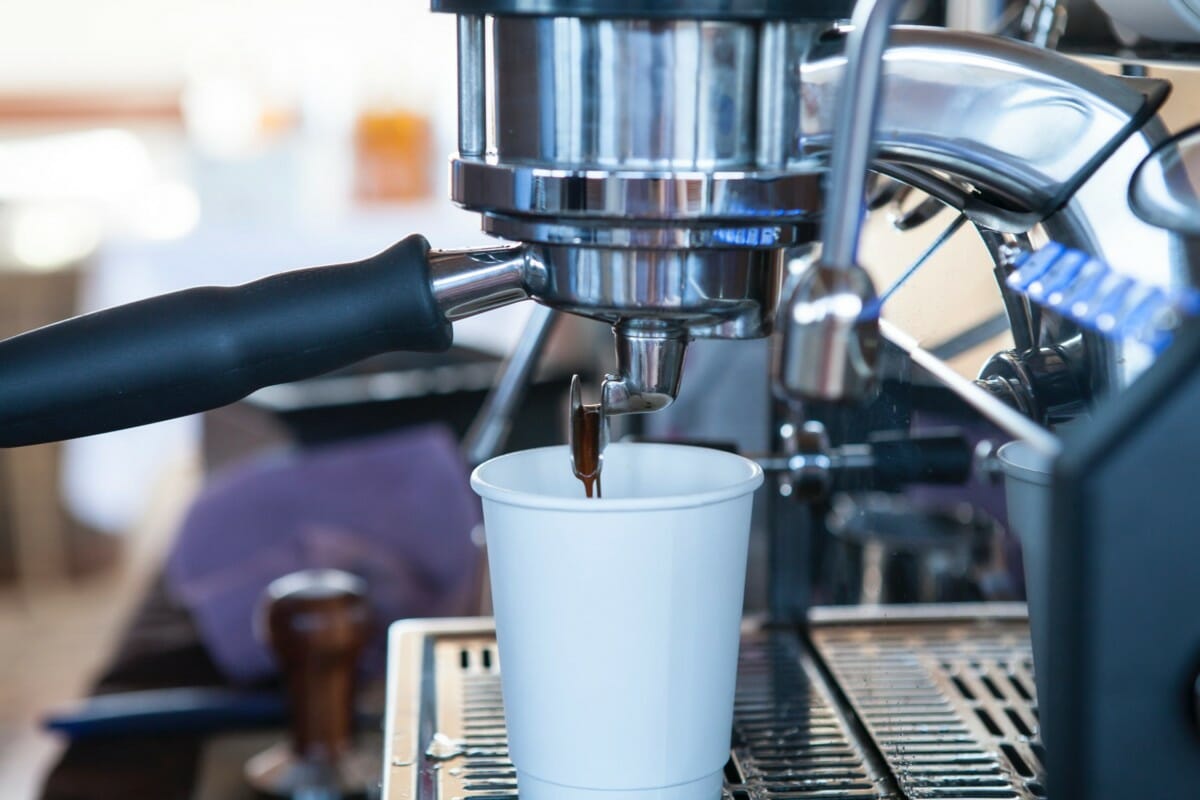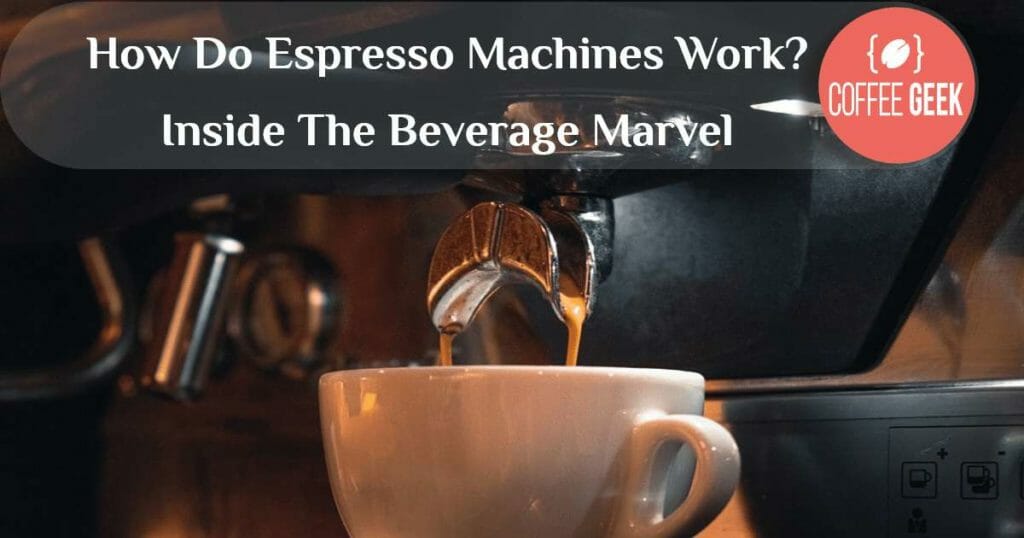While you were sitting there drinking your morning espresso, it occurred to you that you have no idea how the machine that made your morning beverage actually works.
The nuts and bolts of an espresso machine are actually fairly simple, but the intricacies of these amazing machines have a huge impact on the way your espresso will end up tasting.
Temperature has a huge impact on the act of making espresso. If the boiler cannot regulate temperature adequately then you can heat up your coffee grounds too much and end up with a burnt and bitter drink.
If the heating element doesn’t work well in your steam wand, then you can forget about a good froth on your cappuccino.
In this article, we will explore all the important pieces of information that you need to know to adequately answer the question, “How do espresso machines work?“.
We will discuss the terminology used to describe the components of an espresso machine, how the different parts work, which coffee to choose for that perfect cup of espresso, and if buying home espresso machines are really worth it.
Espresso machine lingo
Before we look into how to make an espresso machine work, we need to go over all the key terms you should know with regard to espresso and espresso machines.

- Water source: This is a water reservoir usually at the back of the espresso machine.
- Water pump: This is the part of the espresso machine that brings the water from the reservoir to the boiler; it is sometimes referred to as the “heart” of an espresso machine.
- Boiler: This mechanism is the area where the water goes to be heated to the perfect temperature before it is pushed through the grounds at high pressure.
- Steam wand: A steam wand is what you use to make your milk foam, it’s usually a metal cylinder sticking out from the front of the machine.
- Group head: In short, this is where the boiler spits out the water into the coffee filter.
- Portafilter: Also known as the group handle, this piece is attached to the group head and carries a “coffee puck” (packed coffee grounds) in a filter.
- Filter basket: This is just a small metal basket carrying packed coffee that rests in the portafilter.
- Pulling a shot: This just means to make a shot of espresso. In the past baristas needed to create pressure in the boiler in order to push water through the grounds (using a Gaggia style machine-circa 1938) using a lever style machine. The barista had to pull on the lever to make a shot, which pushed water through the grounds and created a creamy froth atop the espresso.
- Espresso: Full flavored and concentrated coffee that is served in shots, not cups. It is much stronger than the average cup of joe and is the coffee component to beverages like cappuccinos, lattes and macchiatos.
How do espresso machines work?
Espresso machines consist of seven basic elements.
Home espresso machines and commercial machines all use these same parts but in varying capacities.
Since all espresso machine design is relatively similar, for the purposes of this article we will focus primarily on the home espresso machine to investigate how an espresso machine works.
Inside the espresso machine
Espresso machines have come a long way since their creation in 1884.
They have gone from looking like a Dalek out of Doctor Who to the compact, sleek, and sometimes sexy pieces of machinery that sit on the counters of avid coffee connoisseurs and cafes all over the world.
So let’s dig into the mechanics of how an espresso machine works.
Control Panel
Many manufacturers of espresso machines include a control panel, the only exception to this is lever machines, which are hand-operated and not commonly on the market for home use.
Usually, there is a power light that indicates if the machine is on or off.
There is also a temperature control light that shows when the water is heated enough to extract an espresso shot.
Sometimes there is also a valve for controlling the flow of steam into the frothing wand.

Some machines also have switches or gauges that help with pressure and temperature for the size of the shot. Some machines with built-in grinders will have a dial for grind size.
Water Source and Pump
Every machine needs a water source. With home machines, the tank is usually removable and you fill it by hand to the full water line; commercial and some higher-end home machines are equipped with the ability to be plumbed into the water supply for the building.
All the water in the reservoir is not heated. The pump will move the water for brewing from the water tank to the boiler.
Water pressure is measured in a unit called a bar, which is one unit equivalent to 100,000 newtons per meter squared or one atmosphere.
An atmosphere is a unit of pressure equal to mean atmospheric pressure at sea level.
The ideal pressure for espresso is 9 bars to 15 bars, 9 bars being the minimum pressure needed to pull a shot or about 130 psi which is four times as much as the pressure in car tires.
The boiler pressure should be about 1.5 bars. There are a few different types of pumps, rotary pumps, and vibration pumps.
A rotary pump is commonly seen in commercial machines and is mechanical, providing a constant supply of pressure.
Vibration pumps are found more often in home machines and only create pressure when pulling a shot.
The pump is usually regarded as the heart of the machine because without it none of the water would be able to move through the system into the ground coffee to create your beverage.
Boiler
The boiler is an extremely important piece of the machine because the temperature is so crucial to espresso brewing.
It is where the pressurized water is heated in a metal chamber with a heating element inside.
Many manufacturers are using proportional-integral-derivative controllers (PID) or digital temperature controls in their products.
These devices manage the on-off cycles of the heating element to retain perfect boiler temperature.
PID machines have optimal temperature control for the boiler unit. The ideal brewing temperature is just below the boiling point at around 250 degrees Fahrenheit.
Boilers have a one-way valve that prevents the water for the brew to come back up into the machine.

There are three main types of boilers: single boiler, dual boiler, and heat exchanger:
Single boiler–
These machines use a fairly simple concept, there is only one boiler to heat water for the entire brewing process. Both water for the steamer and for the espresso is heating in one tank.
You cannot brew espresso shots and steam milk at the same time with these types of machines. These are often seen in semi-automatic and low-end automatic machines.
The water temperature isn’t as consistent with these types of single boiler machines.
Dual boiler–
You guessed it! There are two boilers in these bad boys.
The biggest difference between the single and double boilers is the that you have two separate tanks boiling water at once with two different heating elements (one is the steam boiler and one is the hot water for pushing through the ground espresso) and thus you can use the steamer and pull a shot of espresso at the same time.
These offer the best temperature stability and are the best way to brew water at a consistent water temperature.
Heat exchanger–
A heat exchange boiler uses a large boiler that has an isolated section within it that’s away from the heating element.
This section will allow for water that is less hot and more suitable for pushing through ground coffee.
Water is constantly kept going through the isolated section, into the group heads, and back into the whole unit.
This kind of boiler provides a lot of temperature control and allows the machine to do two things at once, effectively a heat exchange.
Steam wand
A lot of machines also have steam wands, which steam milk. This is the skinny metal straw that attaches to the side of the machine.
It releases the steam from the boiler, the hotter one in a dual system, and into the milk.
The steam heats up and adds a foamy texture to the milk, creating the ideal milky creation for lattes.
Grouphead and portafilter
The grouphead is the part of the system that allows the pump to deliver hot water under pressure to the coffee puck waiting inside the portafilter for brewing.
Group heads have two small holes inside of it that creates a cross-sectional flow of hot water onto the ground coffee inside the portafilter.
Group heads also include a portafilter lock, which is a pressure switch to regulate the boiler pressure.
A portafilter will lock into the grouphead and are sometimes equipped with a 3-way valve that releases pressure from between the portafilters and group heads after brewing, these are called a solenoid valve.
If your machine doesn’t have one then you must wait for the pressure to go down after pulling your first espresso before removing the portafilter to avoid a “portafilter sneeze” which is a burst of hot pressured steam when removing the portafilter from the grouphead.
The portafilter is a removable part that holds all the ground coffee inside of a filter basket. There are two types of portafilters, bottomless and spouted.
Spouted portafilters have two spouts below the basket that allow the espresso to come out of the whole unit and into your cup.
Bottomless portafilters do not have the spouts and allow the espresso to come directly out from the basket. Bottomless portafilters yield much better quality espresso shots and also look better doing so.
Are espresso beans different from coffee beans?
When espresso was first popularized, coffee growers didn’t have the capacity to grow beans with such variety and attention to flavor profile detail.
It was very apparent when a lesser quality bean was used to make espresso because espresso is just a concentrated version of a cup of coffee.
But the truth is that there is literally no difference at all between the beans used in coffee and in espresso coffee.
Modern espresso, especially specialty bean growers and cafes pay special attention to the coffee that go into making an espresso shot.
The flavor can change drastically depending on where you get your beans, how they are roasted, and what method you choose to brew your grounds.

Another important factor of espresso is grind size, if the grind is too fine then no water will be able to pass through it and you’ll end up with a super bitter and condensed shot of espresso.
If the grind is too coarse, then water will pass through too quickly and you’ll end up with a cup of dirt water.
A quick guide to the flavor you’ll get from different beans:
- Arabica- sweeter, delicate, less acidic, good for milky coffee drinks
- Robusta-strong, harsh, bitter, hints of chocolate or rum, often blended with other beans
- Liberica- aromatic, fruity, flowery, woody, a rare bean type due to difficulty to cultivate
- Excelsa- tart, fruity, unique profile like Liberica beans
Is an espresso machine worth it for your home?
If you are the type of person who visits your specialty coffee shop every single day multiple times for a seven dollar cup of espresso with frothy milk and pumps it into your veins like it’s going out of style then home espresso machines might actually save you a lot of money in the long run.
If you are particular about the water, coffee, milk, and hygiene that all goes into making your beverage then an at-home machine would be a good call for you as well.
If you are the kind of person who loves coffee and goes for a Sunday morning espresso but sticks to an average cup of joe every other day of the week then an at-home espresso machine may be excessive and a waste of money.
Having an espresso machine at home can be a wonderful journey but it isn’t for everyone.
Make sure you do your research and choose a machine that is right for you. Check out my recommendations on which espresso machine for the home may suit you.



